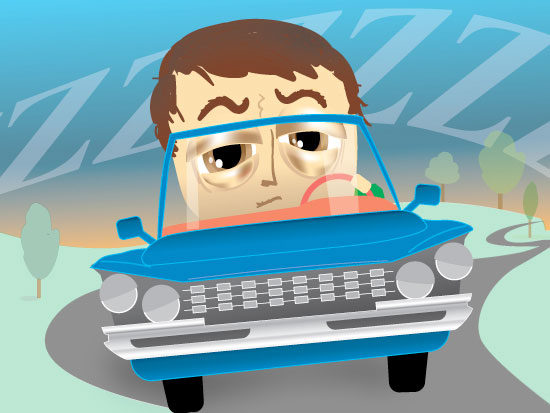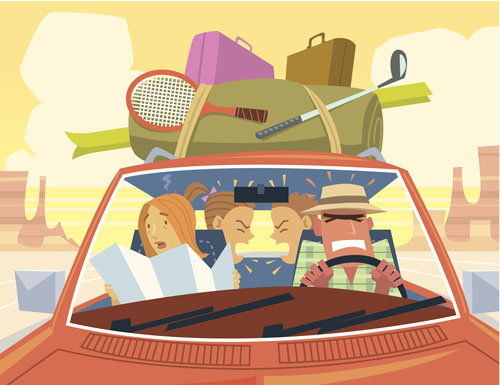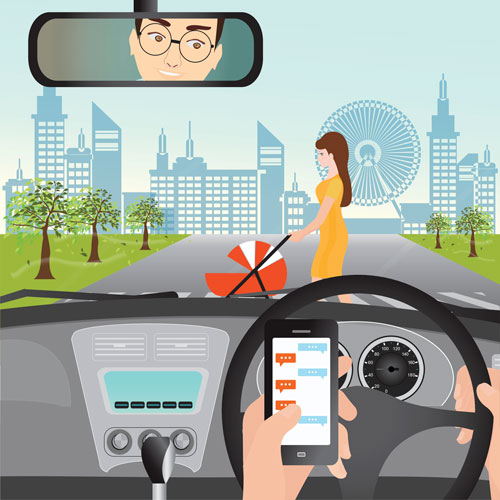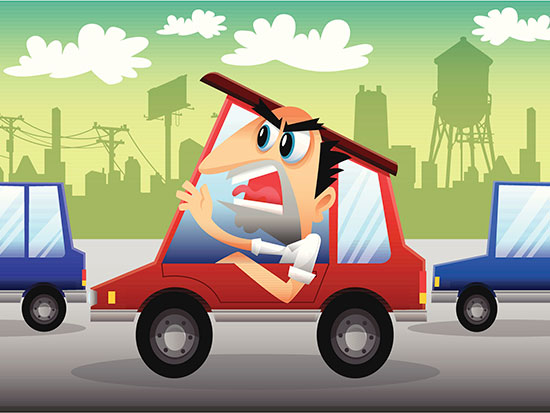More than 32,000 people are killed and 2 million are injured each year from motor vehicle crashes, according to the Centers for Disease Control and Prevention. Each time the car is cranked, it is important to think about the factors that increase the risk of motor vehicle crash, including drowsy driving, driving distractions such as driving with children and texting while driving, and keeping calm while on the road.
 Over the past year, researchers from the University of Alabama at Birmingham have found implications for each of these driving risks and provide tips to safely get to one’s destination.
Over the past year, researchers from the University of Alabama at Birmingham have found implications for each of these driving risks and provide tips to safely get to one’s destination.
Drowsy driving
Conservative estimates show that 21 percent of fatal crashes involve drowsy driving.
“Drowsy driving can be considered a form of distracted driving,” said Benjamin McManus, recent Ph.D. graduate of the UAB Lifespan Development Psychology graduate program in the College of Arts and Sciences and current postdoctoral researcher at the UAB Translational Research and Injury Prevention Laboratory. “As with distracted drivers, cognitive resources are directed away from the task of driving in drowsy drivers.”
Where other forms of distracted driving are externally influenced, like interacting with a cellphone, drowsy driving is an internally influenced distraction; but the result is the same — cognitive and visual resources are withdrawn from driving. In drowsy driving, alertness is drastically reduced, and attentional resources become less available for driving.
McManus compiled research on the topic through his work in UAB’s TRIP Lab, which focuses on the prevention and control of unintentional injuries, particularly those resulting from motor vehicle crashes.
“The statistics are pretty jarring,” McManus said. “Compared to drivers who report typically getting seven or more hours of sleep nightly, those who typically sleep only four to five hours per night are 5.4 times more likely to be involved in a crash.”
Knowing the signs of becoming drowsy behind the wheel, many of which are similar to distracted and drunk driving, could potentially be lifesaving. Signs of drowsy driving, include:
- Increased frequency of blinking
- Longer blink durations
- Slower eye movements
- Falling asleep while stopped in traffic or at a traffic light
- Swerving
- Slowed reaction time
- Poor decision-making
“Recognizing the signs is the first step in prevention,” McManus said. “Following recognition of those indications, you can employ a few different tactics prior to and during driving to help you stay awake.”
The most common prevention and countermeasure techniques include:
- Taking a nap
- Drinking a caffeinated beverage
- Engaging in alertness-enhancing activities while driving (radio adjustments, opening a window, engaging in conversation with passengers, etc.)
- Stopping driving
 “While these activities can help, they aren’t necessarily perfect solutions,” McManus said. “Ceasing driving to take a nap may be the best of these commonly implemented countermeasures, as naps have been shown to reduce driving impairment in such situations. Research tells us that, as a supplement to sleep, naps can be effective for maintaining sustained attention, learning and memory.”
“While these activities can help, they aren’t necessarily perfect solutions,” McManus said. “Ceasing driving to take a nap may be the best of these commonly implemented countermeasures, as naps have been shown to reduce driving impairment in such situations. Research tells us that, as a supplement to sleep, naps can be effective for maintaining sustained attention, learning and memory.”
Driving with children
Children create a different type of danger for drivers, such as distractions and leaving a child in the car. Children can be distracting because drivers are tending to their needs, alongside the dangers of other distractions, such as texting.
Researchers in the UAB Department of Pediatrics found that Alabama parents living in suburban areas use cellphones in the speaker mode, read and send text messages, and surf the web slightly more often than parents in rural areas. Cellphone use among parents who are transporting children is part of a dangerous distracted driving epidemic all too common in Alabama.
“Cellphone use is one of the most common driving distractions among young and adult drivers,” said Kimberly Massey, M.D., principal investigator of the study published in the Journal of Trauma and Acute Care Surgery and fellow in the UAB Department of Pediatrics. “This study proves that further research on how to best implement injury-prevention interventions should be done to target high-risk areas with distracted driving behaviors, like Alabama suburbs.”
When a child is in the car with you, make sure they have what the need before leaving. Make sure the child has gone to the restroom, or change their diaper. Provide water or snacks if they are able to feed themselves, but beware of choking hazards. Provide entertainment, such as a movie or book.
One of the most prominent fears parents have is accidently leaving their children in the car. As a mother herself, Candice Dye, M.D., gives parents a tip that can make the difference in saving a life.
 “I make a conscious point to put my cellphone and purse in the backseat with my child, so I have an additional reminder when I’ve reached my destination,” Dye said. “One can easily forget things, especially if it’s not a part of a normal routine; but forgetting a child in a hot car could be deadly. Placing your cellphone, purse or work bag in the backseat is additional reminder that can make the difference.”
“I make a conscious point to put my cellphone and purse in the backseat with my child, so I have an additional reminder when I’ve reached my destination,” Dye said. “One can easily forget things, especially if it’s not a part of a normal routine; but forgetting a child in a hot car could be deadly. Placing your cellphone, purse or work bag in the backseat is additional reminder that can make the difference.”
Texting and driving
Each day in the United States, approximately nine people are killed and more than 1,000 injured in crashes that are reported to involve a distracted driver, according to the U.S. Department of Transportation National Center for Statistics and Analytics.
“We call texting while driving the perfect storm, as it takes your eyes off the road, your hands off the wheel and your mind off of concentrating on what you should be doing — which is driving,” said Despina Stavrinos, Ph.D., assistant professor in the UAB Department of Psychology. “But it’s not just texting that can be an issue. Checking email, interacting through social media or accessing a map program while driving can also be distracting and dangerous.”
Stavrinos says a little self-control is called for because our love for devices is not going away, nor should it.
“These are very valuable tools, and we’re not going to give them up,” she said. “But we have to balance the benefits of staying connected while mitigating the impact of the distractions, whether it’s while driving, walking down the street or even having dinner in a restaurant.”
 Stavrinos advises that, while driving or doing any task that requires full concentration, one should put the phone far enough away to not be tempted to pick it up at the first ding. She also suggests that distancing from devices every so often will make that easier.
Stavrinos advises that, while driving or doing any task that requires full concentration, one should put the phone far enough away to not be tempted to pick it up at the first ding. She also suggests that distancing from devices every so often will make that easier.
Keeping calm while driving
According to the AAA Foundation for Traffic Safety, aggressive driving behaviors are quite commonly reported. Nearly 80 percent of drivers express anger, aggression or road rage behind the wheel at least once in the past year. The most common aggressive behaviors reported were tailgating, yelling at another driver and honking to show annoyance or anger.
Driving can be stressful, and many drivers may develop aggressive behaviors while behind the wheel, including constantly being in a hurry and road rage. Aggressive driving is characterized as unsafe driving behavior performed deliberately with ill intention or disregard for safety. Some examples of aggressive driving are making frequent or unsafe lane changes, tailgating, running red lights, and speeding. Extreme aggressive driving can escalate to what is known as “road rage.” Drivers may make rude or obscene gestures and even force another driver off the road, or worse.
“Remaining calm is important,” Stavrinos said. “Other drivers can be inconsiderate or driving illegally. These people are not thinking about their safety or the safety of those around them. Don’t take other drivers’ mishaps personally. They are more than likely distracted or upset by other factors.”
For more than two decades, speeding has accounted for nearly a third of all traffic fatalities each year. Speeding can significantly increase crash risk and increases the likelihood of receiving a citation.
“Slow down,” Stavrinos said. “Try to leave a little earlier to account for unexpected delays. Keep in mind that speed limits were put in place to protect all road users.”
Everyone is busy and dependent on the transportation system to provide fast, reliable means of accomplishing daily tasks. When the unexpected happens, such as heavy traffic or catching a series of red lights, it can be frustrating and can lead some to take those frustrations out behind the wheel. It is best to remain calm to avoid unfortunate encounters with other drivers or law enforcement.